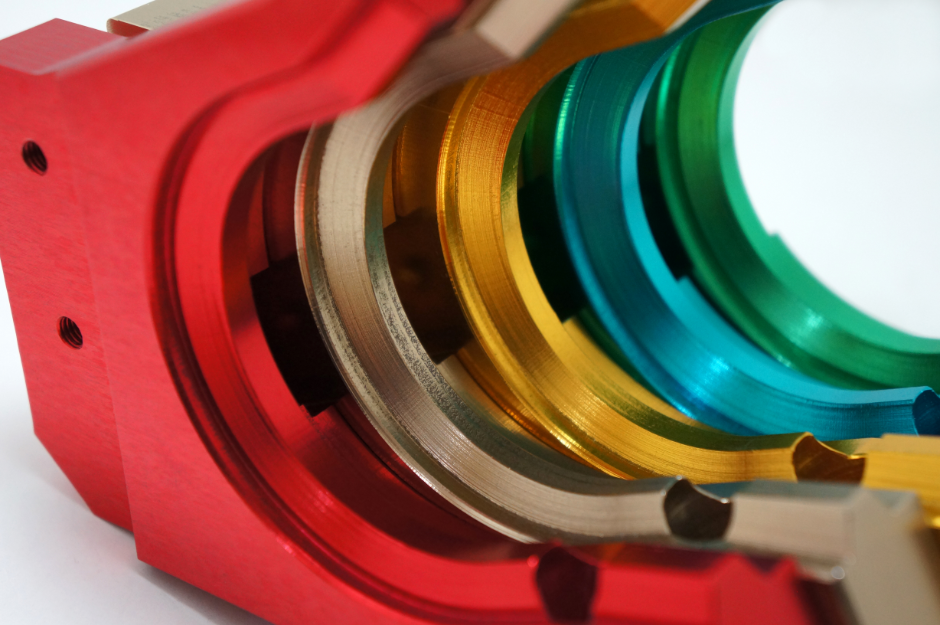Aluminum is one of the most common materials we work with at Approved Machining, and for good reason. It’s durable, lightweight, and cost-effective, and can also be precision machined to tight tolerances. But like most metal parts, machined aluminum often requires finishing.
Among the many finishing options for aluminum, anodizing stands out as one of the most popular and versatile, offering a variety of benefits. But is it the right finishing process for your machined aluminum parts?
In our comprehensive CNC machining services, we aim to help you achieve the best results possible — and that means collaborating with you to weigh your options.
Table of Contents
Key Benefits of Anodizing Precision Machined Aluminum Parts
Anodizing is an electrochemical process that involves submerging parts in an electrolytic bath to create a protective oxide layer on the part’s surface. It forms a barrier between the raw aluminum and the surrounding environment that is thinner than paint or powder coating.
Anodizing is an effective and long-lasting finishing process that provides a host of benefits to improve durability and resistance to environmental conditions, including:
Advanced Corrosion Resistance
Like most metals, aluminum is susceptible to corrosion when exposed to harsh environments or certain chemicals. While it won’t rust like iron-rich metals such as carbon steel, pitting and other surface imperfections can occur. Not only can this significantly impact the longevity of parts, but it can also impact their performance.
However, when precision machined aluminum parts are anodized, the oxide layer forms a lasting barrier to protect parts from corrosion. This makes anodized parts suitable for use in outdoor environments, critical applications, and in areas where they may be exposed to chemicals.
Improved Surface Hardness and Wear Resistance
The oxide layer produced by the anodizing process creates a durable, high-quality surface finish that’s harder than untreated aluminum, making it more resistant to wear, abrasion, and minor impacts. Additionally, as the oxide layer is chemically bonded to the aluminum, it won’t chip or peel.
Anodizing offers aesthetic appeal, but improved surface integrity and long-lasting performance are often the primary motivations. For parts that experience frequent contact, friction, or mechanical stress, the process can help reduce premature wear and dimensional degradation, ensuring long-term performance and lower replacement costs.
Better Adhesion for Paints and Coatings
The oxide layer created in anodizing is porous, and that texture provides an excellent base for primers, paints, and adhesives, which bond far better to porous surfaces than smooth ones.
Not only does this improve the application process and reduce the potential for finishing errors that require rework, but it also improves the overall durability of the coating. As a result, coatings remain intact even under mechanical stress or during intense environmental exposure, extending the life of a finished part and reducing maintenance costs.
Reduced Electrical Conductivity
Though bare aluminum is an excellent electrical conductor, when aluminum is anodized, the oxide layer acts as a dielectric insulator, preventing conductivity. This allows aluminum parts to be used in applications where electrical isolation is needed to prevent short circuits or interference with sensitive components.
This means that anodized aluminum parts can be used for housings or enclosures in electronic systems, where unintentional grounding or signal interference must be prevented. Additionally, anodization also enhances safety by minimizing the risk of accidental electrical contact in high-voltage environments.
Environmental and Chemical Resistance
In addition to protection from corrosion, because the anodized layer is chemically stable and non-reactive, it helps prevent degradation caused by exposure to UV rays, as well as many solvents, chemicals, and industrial cleaners. By being able to withstand exposure to strong sunlight and many corrosive agents, anodized aluminum parts deliver reliable, long-term performance in demanding applications like aerospace and automotive systems.
Lightweight Protection
While coatings and plating can also protect parts from harsh environmental conditions, they typically add more weight and thickness than anodizing. Not only does this make a part heavier, but it can also bring it out of tolerance.
In contrast, anodizing forms a thin, lightweight layer while still offering exceptional protection. That’s why, for many tight-tolerance parts and those with critical applications, anodizing is the go-to finishing process. This is particularly important for parts like aerospace components, which often undergo extensive design revisions to reduce weight.
Aesthetic Enhancement and Color Options

Beyond its protective properties, anodized finishes are also an excellent way to enhance a part’s aesthetics. Anodizing parts creates a uniform, attractive finish, and with the Type II anodizing process, parts can be dyed in a variety of colors while retaining a metallic appearance.
Anodizing can be a cost-effective technique for adding brand colors to products or enabling color variation in a product lineup. Colored anodized parts can also offer functional benefits—for instance, your team can more quickly identify parts or tools with distinct colors in fast-paced maintenance settings.
Achieve Exceptional Anodized Finishes with Approved Machining
Anodizing precision machined aluminum parts is an excellent way to enhance their durability and extend their lifespan. Not only does anodizing provide resistance to environmental factors, prevent corrosion, and increase durability, but it also enhances a part’s appearance with consistent finishes and color options.
However, when it comes to determining the right finish for your precision machined aluminum parts, it’s important to weigh your options carefully and partner with a manufacturer who can guide you to the right solution.
At Approved Machining, we’re experts in precision machining and can help you navigate the finishing process from start to finish. Our in-house CNC machining services, combined with our extensive network of finishing vendors, can streamline your complex machining projects and achieve exceptional results.
Whether you need a manufacturing partner for high-quality prototypes or have a project that requires low-volume production of complex parts, reach out and request a quote today.
